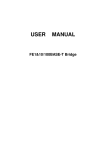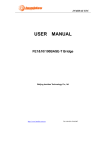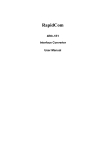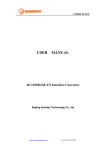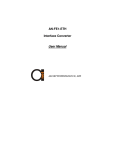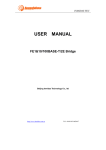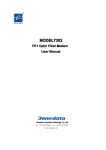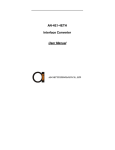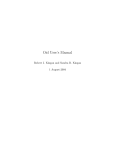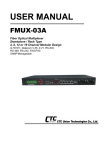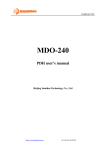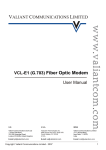Download USER MANUAL E1/100BASE-FX Interface Converter
Transcript
INMIDAS TEC USER MANUAL E1/100BASE-FX Interface Converter Beijing Inmidas Technology Co., ltd http://www.inmidas.com.cn Tel:+86-010-51662447 E1/100BASE-FX Interface Converter User Manual Content 1. Description........................................................................................................................................................ 3 2.Typical scheme................................................................................................................................................... 3 3. Technical specifications .................................................................................................................................... 4 4 Installation and Panel description ...................................................................................................................... 5 4.1 Unpacking (stand alone E1 to Optical Ethernet Interface Converter)...................................................... 5 4.2 Front and rear panel of the stand alone device ......................................................................................... 5 4.3 Front and rear panel of the rack mount .................................................................................................... 6 4.4 whole equipment installation ................................................................................................................... 8 5. Applications of FE1&10/100Base-T Bridge ..................................................................................................... 9 5.1 Definition of balanced twisted-pair wire sequence for RJ45 interface..................................................... 9 5.1.1 10/100BASE-T interface wire sequence..................................................................................9 5.1.2 E1 interface wire sequence ......................................................................................................9 5.2 Setting of DIP switch and jumper ............................................................................................................ 9 5.2.1 Setting of E1 interface impedance.........................................................................................10 5.3 Configuration of Ethernet connecting devices ....................................................................................... 10 5.4 Simple self-test methods for devices and E1 circuits............................................................................. 11 5.5 Typical applications................................................................................................................................ 11 5.6 Common questions and their maintenance............................................................................................. 12 http://www.inmidas.com.cn Tel:+86-010-51662447 Page 2 of 12 E1/100BASE-FX Interface Converter User Manual 1. Description E1 to Optical Ethernet Interface Converter with fiber optic interface is a multifunction and high performance L2 switch which build in three port cross engine to realize the conversion between two Ethernet interface and E1 interface. The equipment supports the function used as Ethernet transceiver or Ethernet net bridge or fiber optic modem. As the extension of Ethernet, This converter may realize Ethernet interconnection at low cost via the E1 channel provided by existing network. The optical Ethernet Interface Converter( also as Optical Ethernet Interface bridge) is a high performance, which accomplishes the converting between the 10/100M Ethernet port、the 100M Ethernet Optic Interface and E1 interface. As an extended device of the Ethernet, the optical Ethernet Interface Converter realizes interconnection of two Ethernet by using the E1 channel provided by exiting networks with the low-cost. 10/100Base-T (RJ45) interfaces are provided at the end of Ethernet LAN to accomplish various functions including MAC address self-learning, address filtering, address table maintenance and flow control, support the protect of net storm. Ethernet electric interface (RJ45) realizes 10/100M and HDX/FDX Auto-Negotiation. It can realizes DTE/DCE auto-negotiation (support "straight"-thru and crossover two Ethernet interface) E1 interfaces conforming to ITU-T G.703 and G.704 proposals are provided at the end of WAN, supporting RJ45 and BNC connection modes. The E1 ports support both framing and un-framing architecture. The user can select an operating mode for the E1 interface according to the connected E1 environment. This provides flexibility of network application. In the framing mode, the E1 interface provides a rate of N*64Kbps (N=1~31). In the un-framing mode, the E1 channel provides a rate of 2.048Mbps and accomplishes transparent transmission. If the Optical Ethernet Interface Converter is used in the framing mode, the transmission clock can be either provided internally, i.e. using the main clocking timing mode (INT), or extracted from the E1 channel, i.e. using slave clock timing mode. 2.Typical scheme The optical Ethernet interface converter provides plenty of self-test functions, supporting local loop and remote loop. It also provides pseudo random code test function to test error codes in the circuit. The device supports conversion between: 1. 10/100Base-TX and 100 Base-FX 2. 10/100Base-TX and G.703 3. 100base-FX and G.703 It is proposed to use the products of this series in pairs. A typical application is shown in figure 1. FE1/ETH ET H POWE R SWITCH-FIBER LN K R X TES T E 1 LO F TX A LO S A S CR C LOO P PTO K SD SDH H FE1/ETH ET H POWE R LN K R X TES T E 1 TX LO F LO S A S CR C LOO P PTO K B SWITCH-FIBER Figure1 typical application of E1 to Optical Ethernet Interface Converter http://www.inmidas.com.cn Tel:+86-010-51662447 Page 3 of 12 E1/100BASE-FX Interface Converter User Manual Another typical application is shown in figure 2. FE1/ETH ET H LN K POWE R SWITCH-FIBER R X TES T E 1 TX LO F LO S A S CR C LOO P PTO K Optical Ethernet Interface Converter SD SDH H FE1/ETH ET H POWE R LN K R X TES T E 1 TX LO F LO S A S CR C LOO P PTO K FE1&10/100 BASE-T Bridge SWITCH Figure2 typical application of E1 to Optical Ethernet Interface Converter 3. Technical specifications Protocol: G.703, G.704, G.736, G.823, I.431 IEEE802.3 10BASE_T Circuit interface (E1): Impedance: 75Ω, physical interface: BNC Impedance: 120Ω, physical interface: RJ45 interface rate: framing: N*64Kbps,N=0~31; un-framing: 2.048Mbps。 Coding: HDB3,Jitter tolerance in accordance with G.823 Output jitter < 0.05UI Data interface (100BASE_T): Impedance: 100Ω, physical interface: RJ45 Interface rate: 100Mbps Coding: Manchester Cable: 75Ωcoaxial-cable, UTP5 twisted pair。 Transmission range: circuit interface: BNC: 600m; RJ45: 300m Data interface: 100m Optical line code type: CMI Optical line code rate: 100Mbps Wavelength: 850nm、1310nm、1550nm Optical Connecter: SC/PC Optical type: multi mode 、single mode Transmission distance: single mode: the max distance is 120Km Multi mode: the max distance is 2Km Indicator: indicating power, connection states of data and circuit interfaces, operation state, test state and trouble alarm. Dimensions: stand alone: 154mm (depth) x 190mm (width) x 37mm (height) Rack mount: 19in standard 4.5U cabinet Power supply: stand alone: 160V~270V AC input, 5V/2A output -40V~-60V DC input,5V/2A output rack mount:150V~260V AC input,5V/16A、12V/1A output -38V~-58V DC input,5V/16A、12V/1A output Power dissipation: 3W Operational temperature: 0℃~50℃ http://www.inmidas.com.cn Tel:+86-010-51662447 Page 4 of 12 E1/100BASE-FX Interface Converter User Manual Storage temperature: Humidity: -20℃~80℃ 5%~90% (no condensation) 4 Installation and Panel description 4.1 Unpacking (stand alone E1 to Optical Ethernet Interface Converter) Check the accessories and spare parts when opens the package. In case of missing, immediately contact our offices or agencies. Check for the following items: ■ One E1 to Optical Ethernet Interface Converter ■ An Operation manual ■ A supply cord ■ Two plugs for coaxial cable In case of any damage in transportation, contact our offices or agencies. 4.2 Front and rear panel of the stand alone device The front panel of the Optical Ethernet Interface Converter is shown in figure 3. Figure 3 front panel of Optical Ethernet Interface Converter Explanations for the two rows of indicators at the left are as follows: POWER: Power. Always lights after starting up. LINK(ETH): Link. Link indicator of Ethernet interface. Always lights if the Ethernet link correctly. Flickers when data transfering. RX: Data reception. Flickers when the data interface receives data. TX: Data transmission. Flickers when the data interface transmits data. LOF: Alarm indicator lamp for input signal out-of-frame in E1 line. Constantly lightening indicates the alarm with local device; flash indicates the alarm with opposite device. Alarm status of opposite device can be detected only at framing mode. LOS: E1 link interruption alarm. Always lights after starting up till synchronization is established. It also lights in case of E1 link interruption or signal loss in communication. LINK(FIBER): Link. Always lights if the fiber link is connected. Flickers when data transfer SPEED: Indicator fiber interface’s work rate is 100M(The fiber interface’s work rate of this kind only 100M) LOOP: Test. Always lights in testing (transmitting local or remote E1 interface loop instructions or http://www.inmidas.com.cn Tel:+86-010-51662447 Page 5 of 12 E1/100BASE-FX Interface Converter User Manual pseudo-random sequence test instructions). PTOK:Circuit pseudo-random sequence test success. In the state of remote E1 interface loop, transmits pseudo-random codes to the remote equipment via local E1 interface, and checks for error codes according to the pseudo-random codes received at the local E1 interface. If there is no error code, the indicator lights. This function can be used to check the E1 circuit. Note: Circuit pseudo-random sequence test is valid only when the local equipment is in the framing mode and main clock is configured. z The AC input rear panel of Optical Ethernet Interface Converter is shown in figure 4. Figure 4 AC input rear panel of optical Ethernet Interface Converter 220V AC: AC socket with two cores OFF/ON: Power switch. When the ON button is pressed down, the power supply is turned on 8 bits coded E1-75Ω TX/RX: BNC transmission/reception socket for 75Ω impedance E1 interface E1-120Ω: RJ45 socket for 120Ω impedance E1 interface TX RX: socket for E1 transfer, TX indicator of E1 data transmission, RX indicator of E1 data receives. 10BASE-T: RJ45 socket for 100Mbps Ethernet interface z The DC input rear panel of Optical Ethernet Interface Converter is shown in figure 5. Figure5 DC input rear panel of Optical Ethernet Interface Converter 48V DC: DC -48V power supply connector The others are the same as in figure 4. 4.3 Front and rear panel of the rack mount z Front and rear panel of the rack mount, its shown in figure 6 http://www.inmidas.com.cn Tel:+86-010-51662447 Page 6 of 12 E1/100BASE-FX Interface Converter User Manual Figure 6 Front panel of RACK +5V: 5V main power indicator +12V: 12V fan power indicator Underneath the panel there are a indicator matrix. See figure 7 about the description of the front panel of optical Ethernet Interface Converter for its functionality. z The rear panel of RACK/AC is shown in figure 7. Figure 7 panel of rack/AC The panel above consists of three different small panels: as described below: ¾ The small panel of optical Ethernet Interface Converter module, as shown in figure 8. figure 8 Panel of optical Ethernet Interface Converter module See figure 4 about the description of AC input rear panel of optical Ethernet Interface ¾ The panel of RACK/AC AC redundant power supply is shown in figure 9. Figure 9 Panel of rack/AC AC redundant power supply 160-270VAC: AC 220V input socket ON OFF: power converter +5V: 5V main power indicator +12V: 12V fan power indicator ¾ The panel of RACK/DC DC redundant power supply is shown in figure 10. http://www.inmidas.com.cn Tel:+86-010-51662447 Page 7 of 12 E1/100BASE-FX Interface Converter User Manual Figure 10 Panel of rack/DC DC redundant power supply 40-60VDC: DC-48V connector (FG to protective GND, “-+” is the polarity of the –48V DC input) ON OFF: power converter +5V: 5V main power indicator +12V: 12V fan power indicator 4.4 whole equipment installation Optical Ethernet Interface Converter installed indoor normally, rack can placed on the desk or wall. If it be placed on general 19 inch rack , you’ll add two bars under the low-cover, its shown in figure 11 Figure 11 for Engine of Stand alone Rack will be placed on general 19inch rack, the operation by step is blow: Tack out the ten M3×6 breechblock on the flank of the box, which is shown in figure 12 Figure 12 The figure one for the rack Tack out the pair of bend-element in the appendix, attention no exchange the left & right. Make the bend-element on the flank of the box by the ten M3×8 breechblock on the appendix ,which is shown in figure 13 http://www.inmidas.com.cn Tel:+86-010-51662447 Page 8 of 12 E1/100BASE-FX Interface Converter User Manual Figure 13 The figure two for the rack E1 interface line will fetch out from BNC socket or RJ45 socket which are on the rear panel, Ethernet interface line also from the RJ45 socket on the rear panel, fiber interface too. 5. Applications of FE1&10/100Base-T Bridge 5.1 Definition of balanced twisted-pair wire sequence for RJ45 interface 5.1.1 10/100BASE-T interface wire sequence The RJ45 Unshielded twisted-pair for 10/100BASE-T interface can use DCE or DTE standard stipulations, it support AUTO MDI/MDX function. As shown, wire 1 and wire 2 are sending wire, and wire 3 and wire 6 are receiving wire. 1 2 3 4 5 6 7 8 TX+(Positive of data sending ) TX-(Negative of data sending) RX+(Positive of data receiving) Unused Unused RX-(Negative of data receiving) Unused Unused Figure 13 RJ45 Twisted-Pair Wire Sequence for Ethernet Interface 1 2 3 4 5 6 7 8 5.1.2 E1 interface wire sequence Figure 14 RJ45 balanced twisted-pair interface wire sequence for E1 1 and 2 are transmitting lines, 4 and 5 are receiving lines, as shown in figure 14. 5.2 Setting of DIP switch and jumper For a rack mount unit, the module can be easily drawn out from the guide channel just by unscrewing the http://www.inmidas.com.cn Tel:+86-010-51662447 Page 9 of 12 E1/100BASE-FX Interface Converter User Manual screws on the module panel. 5.2.1 Setting of E1 interface impedance Bottom coded switch, as shown in Figure 18 : E1 TS 0 7 ON 1 15 ON 2 3 4 5 6 7 8 1 ON 2 3 4 5 6 7 8 31 23 1 ON 2 3 4 5 6 7 1 8 2 3 4 5 6 7 8 Figure 15 E1 Time Slot Setting After time slot 0 is valid, other coded switches in whatever positions are all valid. Select the number of time slots according to the expected rate. Normally for an independent type, a time slot setting of automatic tracking Central Site module is selected. Coded switches of plate-clip time slot correspond to S1, S2, S3 and S4. SW Status 0 ON OFF 16 Function Unframed 2048KBps CCS (PCM31) ON Status Function Default / / OFF OFF CAS (PCM30) OFF OFF ●1st switch (S1.1) is used for controlling E1 framing/non-framing. “ON” refers to non-framing mode (2.048Mbps). ●31 switches, from 2nd—32nd (S1.2~S1.8, S2, S3, S4), are respectively used for controlling the selection of 1st –31st time slots. Set at “ON”, the corresponding time slot is selected; set at “OFF”, the corresponding time slot is not selected. The rate of E1 interface is completely dependent on the number of the selected time slots. For example: the setting of 3rd switch to “ON” and all other switches to “OFF” indicates that 2nd time slot is selected, at this moment the rate is 64K; the setting of 7th and 8th switches to “ON” and all other switches to “OFF” indicates that 6th and 7th time slots are selected, with a rate of 2*64K=128K. TSO setting is used for specifying E1 frame to be transparent or framing: ‘0’--framing, “1”--non-framing. But the bit has to be specified in combination with other time slots. TS16 setting is used for controlling E1 frame structure to be PCM30(CAS)or PCM31(CCS): ‘0’—PCM30, at this moment 16th time slot must not be used for transmission service; ‘1’—PCM31, 16th time slot can be used for transmission service. Besides, TS1—TS31 are respectively used for controlling the selection of 1st—31st time slots: ‘1’—the corresponding time slot is selected; ‘0’—the corresponding time slot is not selected. 5.3 Configuration of Ethernet connecting devices The equipment uses 10/100BASE-T Ethernet interfaces and supports adaptive 10/100M half/full duplex mode. Ethernet devices connected to FE1&10/100BASE-T bridge (such as SWITCH, HUB, Ethernet adapter card (NIC), etc.) can be set to 10M full duplex, 10M half duplex, adaptive 10M half/full duplex and adaptive 10/100M. Note: Ethernet devices connected to FE1&10/100BASE-T Bridge can not be set to the enforced operating rate http://www.inmidas.com.cn Tel:+86-010-51662447 Page 10 of 12 E1/100BASE-FX Interface Converter User Manual of 100M. 5.4 Simple self-test methods for devices and E1 circuits Test 1: test of back-to-back connection Connect two FE1&10/100BASE-T bridge devices back to back, ping the other’s IP address on the two computers to test the two devices. PC1 PC2 A B FE1/ETH FE1/ETH ET H E1 ET H Test 2: LNK TX RX LOF E1 TEST TEST PO WER PO W ER AS LOS L OO P CRC LN K RX TX LOF L OS AS LO O P C RC PT O K PT O K test of E1 circuit transmission error codes. Connect the device in the real operational environment, check the E1 circuit with the loop and pseudo-random sequence test function provided by the device. If the exchange end and the user end is very far away, the E1 circuits of the two FE1&10/100BASE-T bridge must be correctly connected first. Otherwise, indicator LOS will always light. Set the device at the exchange end to framing and main clock mode, set S5.1 (RLOOP) to ON, pseudo random sequence test will be executed. If indicator TEST and indicator PTOK at the exchange end always light, it indicates successful loop and pseudo random code test and the E1circuit has no error code. S5.1 S5.5 ON ON A FE1/ETH B ETH POWER LNK RX LOF LOS SDH TEST E1 TX AS CRC LOOP PTOK FE1/ETH ETH POWER LNK RX TEST E1 TX LOF LOS AS CRC LOOP PTOK 5.5 Typical applications Mode 1: connect Ethernet with E1 networks. SDH, PDH and DDN networks have already been widely adopted. With E1 channels provide by such networks, bridging connection and interconnection of two Ethernet networks at different locations can be easily realized SDH FE1/ETH ETH POWER LNK SWITCH/HUB RX E1 TX LOF LOS TEST AS CRC LOOP PTOK FE1/ETH ETH POWER LNK E1 RX TX LOF LOS TEST AS LOOP CRC PTOK B A SWITCH/HUB by the FE1&10/100BASE-T bridge. Connecting two Ethernet networks with an E1 network. Mode 2: Extend an Ethernet network with existing twisted pair or coaxial cable. Connected with twisted pair or 75Ω coaxial cable, the E1 ports of FE1&10/100BASE-T Bridge support a transmission range of 300m or 600m. Two Ethernet networks at different locations can be bridged by two FE1/eth FE1/eth ETH E1 ETH LNK RX TX LOF A LOS E1 TEST TEST POWER POWER http://www.inmidas.com.cn SWITCH/HUB AS CRC LOOP LNK RX TX LOF LOS AS CRC LOOP PTOK PTOK Tel:+86-010-51662447 B - SWITCH/HUB Page 11 of 12 E1/100BASE-FX Interface Converter User Manual FE1&10/100BASE-T bridge with existing twisted pair or coaxial cable. Extending Ethernet with existing twisted pair and coaxial cable 5.6 Common questions and their maintenance (For independent interface converter, reference for frame bridge) No. 1 Symptoms Causes Remedies The power indicator The power circuit 1. The power is not connected. Check the contact of does not light after has a failure. the power lines and the converters. starting up. 2. The internal fuse of the equipment is broken. Replace the fuse. 3. The internal power module has a failure. Send it rear to factory for repair. 2 Indicator LNK does Integrity test of link 1. The type of the cable does not meet the DTE/DCE not light when the has not passed. modes of the Ethernet ports of the equipment. Ethernet network is 2. The crystal head of the cable is not well molded. connected. Check the quality of the UTP cable. 3. The rate setting of the converter or the network card is wrong. See 5.3. 4. The internal circuit of the equipment is damaged. Send it to factory for repair. 3 Indicator LOS always The circuit signals 1. Check the coaxial cable or the UTP5 twisted pair for lights when the cable are lost. open circuit and short circuit. Check whether the plugs at the E1 port is are positioned. connected. 2. The factory default of the equipment is 75ΩBNC interface. S5.6~S5.8 should be reconfigured if a 120ΩRJ45 interface is used. See 5.2.1 for reference. 3. The internal circuit of the equipment is damaged. Send it to factory for repair. 4 Indicators are normal, The opposite devices The setting of LLOOP of tumbler converter S5 is but are in the state of wrong. The converter for local loop test should be set local loop test and to OFF(turn up) to make it invalid. communication can not be done. the Ethernet link of the opposite devices has communication. http://www.inmidas.com.cn no The Ethernet link of the opposite interface converter has a failure. Check the opposite devices according to item No. 2 in the table. Tel:+86-010-51662447 Page 12 of 12












